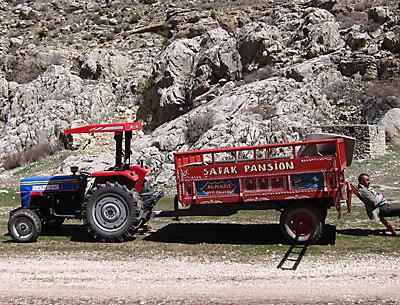Star Gardener: Last Call for Bulbs

It’s difficult to focus on next spring’s garden before Labor Day has even come and gone. However, it is already too late to order fall-blooming crocuses and colchicums, and the deadline for ordering spring bulbs is fast approaching.
The pleasure you’ll have next February, March, and April is well worth the hour or so spent now looking through catalogs or Web sites of bulb dealers and sending in an order. My three favorites are Odyssey Bulbs for treasures (especially corydalis), Old House Gardens for heirloom bulbs, and Brent and Becky’s Bulbs for the rest.
Daffodils and tulips always head the list, but after spending the last two Aprils botanizing for bulbs in Greece and Turkey, it is crocuses and the so-called minor bulbs — anemones, corydalis, scilla, snowdrops, grape hyacinths, and the like — that are commanding my attention this year.
Memories of a valley in the northern Peloponnesus carpeted with dazzling golden adonis begs to be recreated. Snowdrops growing out of crevices and on ledges in the Taurus Mountains in Turkey were astonishing, as much for their location in an inhospitable habitat as for my determination to scale the steep, gravelly slopes intent on getting up close.
Much easier to recreate in sandy woodlands on the South Fork is the jumble of winter aconites, scilla, snowdrops, and lavender Crocus biflorus growing out of oak litter in the snow melt of the Turkish mountains. Mix the bulbs together, dribble over your allotted space, and plant where they land, just as in nature.
Those fortunate enough to have heavier soil ought to try cyclamen, lots and lots of them around the base of trees and shrubs with heavy root competition, and on a slope if possible. Almost every wooded area in Greece and Turkey is carpeted with cyclamen in deep rose that almost take your breath away. In Greece we saw C. repandum and C. hederifolium, and in Turkey, C. alpinum and C. cilicium, all of which are hardy here. With careful selection you can have flowers and patterned foliage in every season.
In sunnier areas, the Grecian windflowers (although they are in Turkey, too), Anemone blanda, grow in colors and forms we can hardly dream of: singles, doubles, shades of blue and purple, pinks, and white. They like moisture in early spring, flowering just as the snow recedes, but a good baking in dry soil in summer. Often we found them growing in small patches of a foot or so across, but many of them and in different colors. In another place they nearly carpeted an entire valley floor, interspersed with crocuses and scilla.
Corydalis solida and other bulbous corydalis species abound in the Taurus Mountains. These are among the earliest flowers to bloom in my garden and flourish in East Hampton, unlike the herbaceous blue corydalis from China that gives up before the heat and humidity really get going. They are in a range of pinks, lavender, white, and the more orangey hues. Strangely we saw almost no cross-pollination. When I began planting my woodland garden, I bought a few bulbs in different colors and let nature do its thing; the result is a multicolored tapestry that covers the ground.
Of the larger bulbs, crocuses are among the earliest to flower, sometimes poking through the snow. If you were to see the graceful crocuses in Turkey and Greece, you’d never look at another large Dutch hybrid again.
Most of the Turkish crocuses were C. biflorus in shades of blue or lavender and C. chrysanthus in yellow, gold, an occasional white, and natural hybrids of the two, some yellow on the inside and bronze on the outside. Selections like Snow Bunting, Cream Beauty, and Blue Pearl were collected a hundred years ago, brought to Holland and have been popular ever since. At altitude on Mount Parnassos and the Chelmos Mountains of the Peleponnesus, C. sieberi, purple with a yellow throat, is king.
We tend to mass the small crocuses in compact groups, but in nature they are scattered here and there or in loose swathes. It is worth stopping at Breadzilla in Wainscott next winter where the crocus plantings mimic the Turkish mountainsides.
One of the first bulbs I ever planted was Fritillaria persica. It has spikes of nodding bells in a sort of mourning purple. It was as odd as anticipated, flowered its first year and never returned. Now I know why: We found vigorous clumps growing in full sun in rocky sites with very lean soil.
Of course you don’t have to ford a wide and stony stream in your bare feet to see a fritillaria new to science, or climb a steep slope covered with boulders and loose gravel in search of a rare scilla, only to later discover a large group of them nearly at eye level by the road. But what fun it was to travel by tractor to reach the snow fields in Emily Valley for one last gorge of the full range of Turkish bulbs.
Having botanized for bulbs makes my ordering of next year’s supply and anticipating next spring’s display a replay of glorious vistas and flowers.
Where to next? The mountains of Crete, renowned for crocuses, colchicums, and sternbergia that flower in November.
Abby Jane Brody is seen in April in the Taurus Mountains of Turkey at an elevation of 6,000 feet during a botanizing pilgrimage that also took her to Greece. From left, she photographed crocus up close, a jumble of snowdrops, scilla, and crocus in the Taurus Mountains, and Tulipa australis on Mount Parnassos, in addition to hundreds of other photos. Her next destination? Crete.
